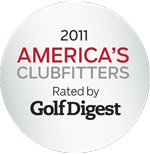Golfers will often ask “what is the hottest driver out there?” The real question is what driver will give them the most distance as if manufacturers are able to make one driver longer than the other. The fact is that in the past 7 years or more almost all drivers have the maximum COR/CT allowed by the USGA. In theory, all drivers should go the same length! This is not the case. One of the most important variables to consider is the effect of custom fitting.
The professional fitter will work with the golfer to find a club head model that maximizes ball speed in relation to swing speed. This ratio is called “Smash Factor” or “Power Transfer Ration.” The objective is to achieve a PTR of 1.50 or a ball speed that is about 1½ times the speed of the club head. The fitter will also work on narrowing the dispersion rate, or the tightness of the shot pattern. One of the most critical aspects in the fitting is to find the proper launch angle for the golfer as this helps send the ball on the correct flight path which is instrumental in achieving the maximum distance. Closely related to the launch angle is the spin rate. Achieving the correct spin rate also helps establish the correct trajectory of the golf ball. To achieve the correct spin rate, the fitter will work with different shafts, lofts, and perhaps even the golf ball. Once all these factors have been matched for the golfer, the driver should be almost at it’s optimum. Ball speed, centeredness of hit on the club face, launch angle, and spin rate are all very important in building the “longest” driver. Equally as important is finding the perfect length of the driver for the player. The golfer has to be able to control what he is swinging. It is equally as important to find the correct MOI of the club for the individual also. Lastly, this writer is a firm believer in proper shaft orientation in the club head to produce consistency in driver performance.
A professional fitter will use a launch monitor and high speed camera to gather the necessary data in order to build the proper driver for the golfer. A variety of other items are used as well such as face tape and weights to work with impact location on the club face. Some golfers will also experience a benefit from a driver that is counter balanced. A qualified fitter will be able to determine this at the time of fitting.
An expert fitter will also consider what suits his player as far as the looks of the driver head. Such things as size of head, weight of head, and location of the center of gravity are all considerations when choosing a club head.
- smaller heads equal more workability and ease of squaring the club face
- larger heads may have a bit more of a forgiving hitting area but are harder to square
- higher MOI clubs are also harder to square but you feel the head more
- lower and deeper center of gravity means a lower spin rate
Having the correct shaft and head combination is critical in the fitting process. The shaft, after all, is the engine of the golf club. The properties of the shaft will most certainly have an effect on the performance of the head. A shaft will alter spin rates and launch angle for example. A professional fitter will be able to determine what the proper shaft dynamics that properly fit your swing are. All shafts are not created equal by a long shot. With so many shafts available on the market today, how does one know what is correct for him. The answer is, he doesn’t. That is where the fitter comes in and in the long run can save you a ton of time and money. Next time you’re about to walk into that retail store and pick up the latest and greatest because “they” say it’s hot and long, ask yourself, how many other “hot and long” drivers have you bought and here you are still looking. Do yourself a favor and consult a qualified professional fitter. You’ll be glad you did!


